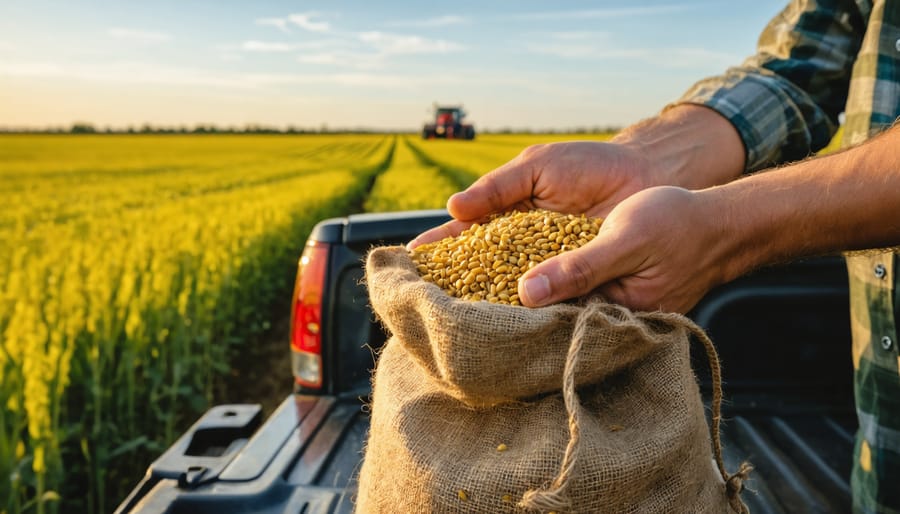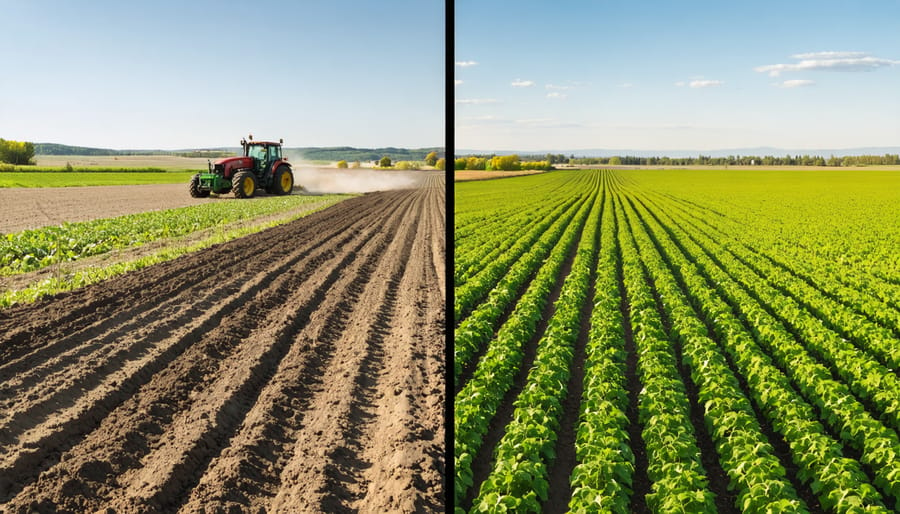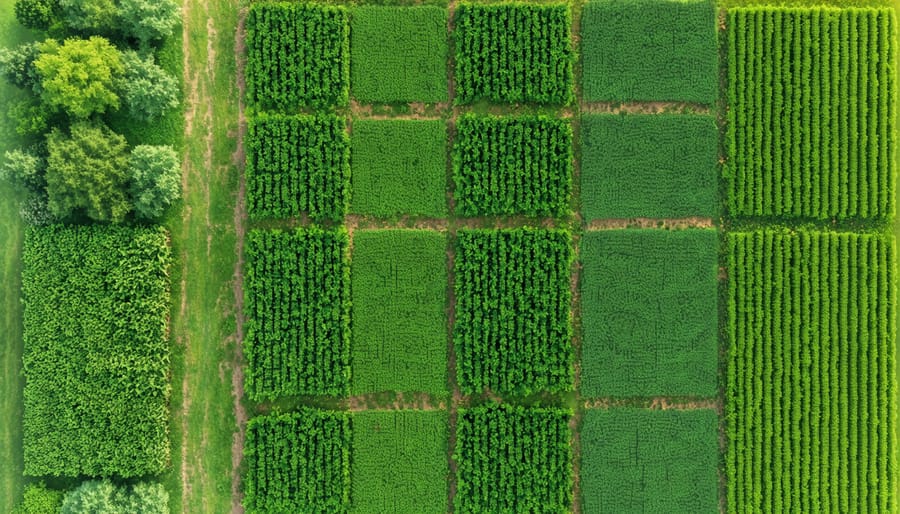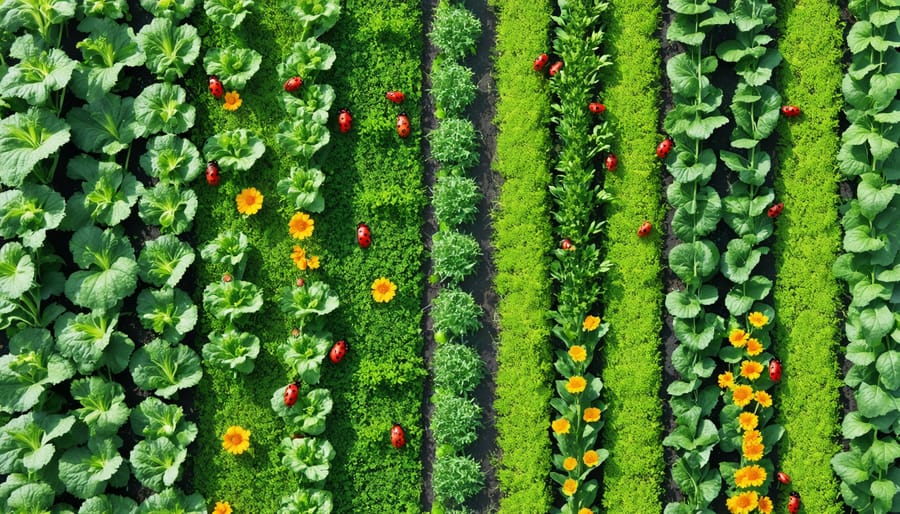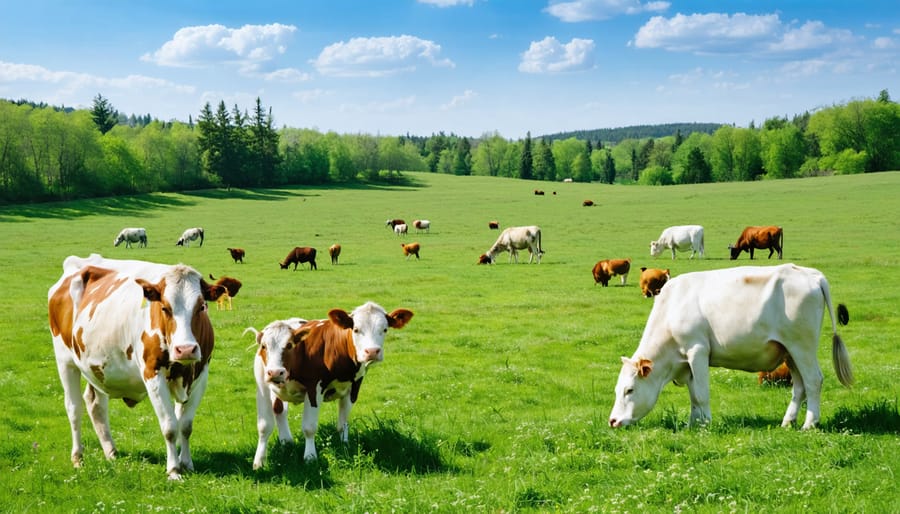Download the official USDA National Organic Program (NOP) regulations directly from the USDA Agricultural Marketing Service website to access the complete legal framework governing organic seed sourcing. These standards require organic operations to source organically produced seeds—certified under the same rigorous protocols as your crops—unless commercially unavailable varieties are documented through your organic certification process.
For Canadian farmers, understanding USDA organic standards proves essential beyond U.S. market access. The Canada-U.S. Organic Equivalency Arrangement means compliance strategies overlap significantly, though key differences exist in documentation requirements and allowable exemptions. Alberta producers exporting organic canola, pulses, or livestock feed must demonstrate parallel compliance with both systems.
The seed sourcing hierarchy remains identical across borders: seek certified organic seeds first, document unavailability through supplier inquiries, then request untreated conventional seeds as exceptions. Your certifier requires written records of these searches annually, specifying varieties, quantities, and supplier responses. This documentation protects your certification status during audits while supporting the broader organic seed infrastructure.
Cross-border seed purchases require additional verification. Confirm your U.S. seed supplier’s NOP certification through the USDA Organic Integrity Database, ensuring their certifier maintains recognition under both frameworks. This dual verification prevents costly shipment rejections and certification complications.
Understanding these regulatory nuances transforms compliance from administrative burden into strategic advantage, positioning your operation for premium markets while strengthening organic agriculture’s foundational principle: building systems from organically grown inputs.
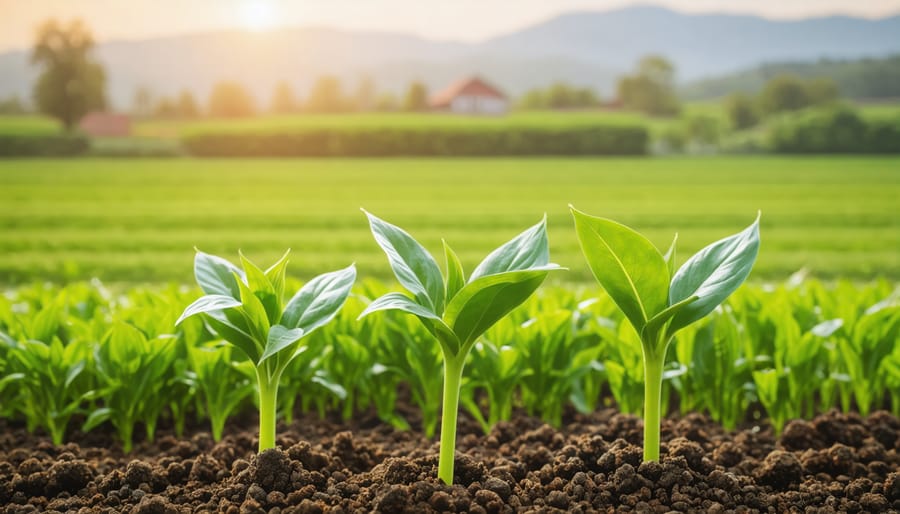
Understanding the USDA Organic Seed Requirements
The Three-Tiered Seed Sourcing System
The USDA organic standards establish a clear hierarchy for seed sourcing that prioritizes organic integrity while recognizing practical realities farmers face. Understanding this three-tiered system helps you navigate compliance efficiently, whether you’re shipping products across the border or simply want to align with best practices.
**Tier One: Organic Seeds First**
Your primary obligation is sourcing organically certified seeds whenever they’re commercially available. This means seeds produced under organic management without prohibited substances for at least one generation. Before purchasing any non-organic seeds, you must demonstrate you’ve made a genuine effort to locate organic options. Document your search by keeping supplier catalogues, correspondence with seed companies, and notes from conversations with organic seed providers. Many Alberta farmers maintain a simple spreadsheet tracking their search efforts—date, supplier contacted, varieties requested, and availability status.
**Tier Two: Untreated Conventional Seeds**
When organic seeds aren’t commercially available for a specific variety you need, you can use untreated conventional seeds. “Commercially available” doesn’t mean you must accept any organic seed regardless of quality, quantity, or delivery timing. The standards recognize that seeds must be available in appropriate forms, suitable quantities, and within your region’s planting window. You’ll need written documentation explaining why organic seeds didn’t work—perhaps the variety wasn’t offered organically, quantities were insufficient for your acreage, or delivery wouldn’t arrive before seeding deadlines.
**Tier Three: Limited Treated Seed Exceptions**
Treated conventional seeds are only permitted when organic and untreated options are genuinely unavailable, and only if treatments aren’t prohibited substances. This exception requires thorough documentation and advance approval from your certifying body. Most Alberta organic farmers find this tier rarely applies given improving organic seed availability.
What Counts as ‘Commercially Available’
Under USDA organic standards, “commercially available” means organic seed can be obtained in the appropriate form, quality, and quantity needed for your operation. The key word here is *can be obtained*—not that it’s convenient or affordable, but that it genuinely exists in the marketplace.
When organic seed isn’t commercially available, you’ll need to document your search efforts. This means keeping records of when you contacted seed suppliers, what varieties you requested, and their responses. Many Alberta farmers maintain a simple spreadsheet tracking supplier contacts, dates, and outcomes. Email correspondence serves as excellent documentation—save those replies indicating organic seed is out of stock or unavailable in your desired variety.
Your certifier will want to see evidence you made reasonable efforts before planting non-organic seed. “Reasonable” typically means contacting at least three organic seed suppliers or checking comprehensive seed databases. For specialized crops or regional varieties common in Western Canada, document any unique growing requirements that made organic alternatives unsuitable.
Best practice? Start your seed search early—ideally three to four months before planting. This timeline demonstrates due diligence and gives you legitimate documentation if organic options truly aren’t available. Keep all records for at least five years, as both USDA and Canadian organic standards require maintaining thorough audit trails for certification compliance.
How USDA Standards Compare to Canadian Organic Regime
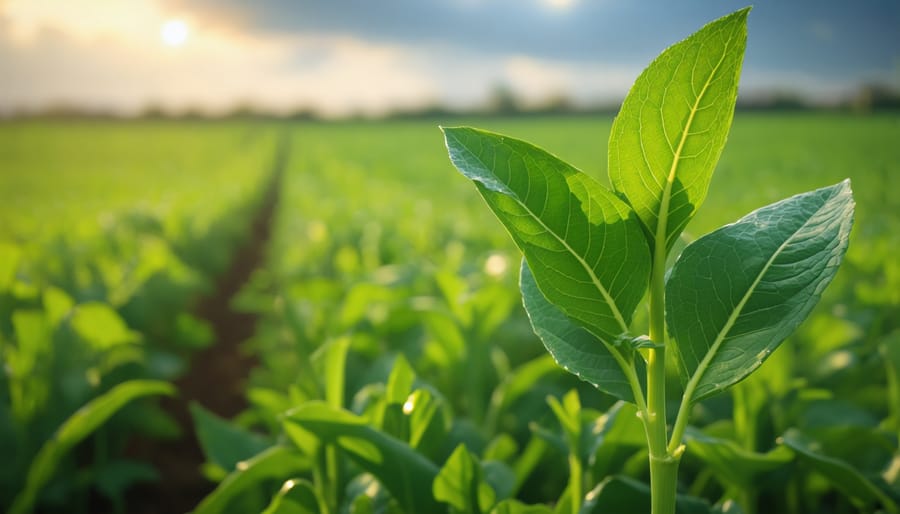
The Canada-US Organic Equivalency Agreement
The Canada-US Organic Equivalency Agreement, established in 2009, creates a powerful opportunity for Canadian farmers by recognizing both countries’ organic standards as equivalent. This means products certified organic in Canada can be sold as organic in the United States, and vice versa—streamlining cross-border trade significantly.
For seed sourcing, this equivalency offers valuable flexibility. When you’re growing organic crops for the Canadian market, you follow the Canadian Organic Standards (COS) requirements for seed sourcing. However, if you’re planning to export your harvest to US markets, you’ll need to ensure your seed sourcing practices also align with USDA organic certification requirements.
Here’s the practical breakdown: Both standards require organic seed when commercially available, with similar documentation expectations for demonstrating unavailability. The key difference lies in specific allowances and record-keeping details. Alberta farmer David Koberinski, who exports organic grains to both markets, notes: “Understanding where you’re selling determines which standard governs your seed choices. It’s about planning ahead and maintaining thorough records.”
Your certifying body plays a crucial role here. They’ll verify that your seed sourcing practices meet the standards required for your target markets. If you’re dual-certified or exporting under equivalency, discuss your seed sourcing strategy with your certifier early in the planning season. This proactive approach ensures your organic seeds meet all necessary requirements, whether you’re selling locally in Alberta or shipping across the border.
Practical Implications for Cross-Border Operations
Understanding both USDA and Canadian organic standards becomes essential when you’re navigating the practical realities of cross-border organic operations. For Alberta farmers, these situations arise more frequently than you might expect.
**Exporting to US Markets**
If you’re planning to sell organic products south of the border, your operation needs to meet USDA organic requirements. While Canada and the United States have an equivalency agreement that generally allows products certified under one system to be sold in the other, specific seed sourcing documentation becomes critical during audits. American buyers often request verification that your seeds meet USDA organic standards, particularly the three-tier search requirement. Keep detailed records of your seed searches, including dates, suppliers contacted, and availability responses—this documentation proves invaluable during export certifications.
**Sourcing Seeds from US Suppliers**
Many Alberta farmers rely on American seed companies for specialty varieties unavailable in Canada. When purchasing from US suppliers, seeds certified as USDA organic automatically meet Canadian organic standards due to the equivalency agreement. However, request documentation confirming the seed’s organic status, including the certifying agency’s information. This paperwork streamlines your annual certification process and prevents complications during inspections.
**Regional Considerations for Alberta Producers**
Alberta’s shorter growing season and unique climate conditions sometimes limit locally available organic seed options. Understanding USDA standards expands your sourcing possibilities while maintaining certification compliance. For example, if you’re growing organic heirloom tomatoes and Canadian suppliers lack suitable varieties, sourcing from certified USDA organic suppliers in Montana or North Dakota provides legitimate, compliant alternatives.
Keep communication open with your certifying body whenever sourcing seeds internationally. They’ll guide you through documentation requirements specific to your operation, ensuring both systems’ standards are satisfied without unnecessary complications.
Prohibited and Restricted Materials in Planting Stock
Seed Treatment Restrictions
Understanding which seed treatments fall outside organic certification helps you make informed purchasing decisions and avoid compliance issues. Under USDA organic standards, synthetic fungicides, prohibited pesticides, and seed coatings containing synthetic materials cannot be used on organic seeds.
Commonly prohibited treatments include captan, thiram, and metalaxyl fungicides—all synthetic chemicals frequently applied to conventional seeds. Even if the seed variety itself is organically produced, these coatings disqualify it from organic use. You’ll also need to avoid seeds treated with neonicotinoid insecticides or synthetic dyes that serve no agricultural purpose.
The good news? Several effective alternatives meet organic standards. Hot water treatments can control seed-borne diseases without synthetic inputs, though they require careful temperature management. Biological treatments using beneficial microorganisms like *Trichoderma* species offer disease suppression while remaining compliant. Physical coatings made from clay, diatomaceous earth, or approved organic materials protect seeds during planting.
Manitoba farmer Tom Richardson shares his experience: “We switched to hot water-treated canola seed three years ago. The initial learning curve was worth it—our germination rates stayed strong, and we maintained our organic certification without compromise.”
When sourcing seeds for your Alberta operation, always request documentation confirming treatment methods. Canadian suppliers familiar with both USDA and COR standards can provide verification letters detailing any treatments applied, giving you confidence in your compliance.
GMO and GE Exclusions
Both USDA organic standards and Canadian regulations strictly prohibit genetic engineering in organic production. This means GMO exclusions apply to all seeds, planting stock, and inputs used on your operation. Under USDA rules, you cannot use seeds or transplants derived from genetic engineering, including newer technologies like CRISPR gene editing.
For Alberta farmers, this creates practical challenges given the prevalence of GE canola in the region. The standards require documented prevention measures to avoid contamination from neighbouring fields. This includes maintaining buffer zones, cleaning equipment thoroughly between uses, and sourcing certified organic or verified non-GMO seeds whenever possible.
If inadvertent contamination occurs despite your best prevention efforts, you won’t automatically lose certification. However, you must demonstrate that reasonable precautions were taken and report any incidents promptly. Keep detailed records of your contamination prevention protocols, seed sources, and field management practices to maintain compliance during inspections.
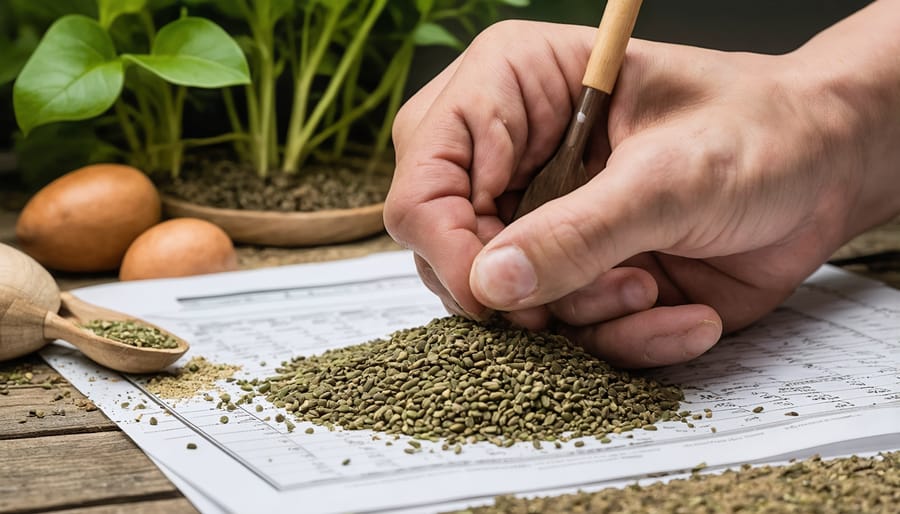
Documentation and Record-Keeping Requirements
What to Document When Organic Seeds Aren’t Available
When organic seeds aren’t commercially available for your operation, thorough documentation becomes your compliance lifeline. The USDA organic standards require proof that you’ve made genuine efforts to source organic seed before defaulting to conventional options.
Start by documenting your search at least three months before planting season—earlier for specialty crops. Contact a minimum of three organic seed suppliers directly, keeping records of every inquiry. Save email correspondence, note telephone conversations with dates and supplier names, and retain any written responses. If suppliers can’t fulfill your order, ask them to confirm unavailability in writing.
Review current seed catalogs from certified organic suppliers, marking the varieties you need and noting when they’re out of stock or unavailable. Take screenshots of online inventory if ordering digitally, as these serve as time-stamped evidence. Many Alberta farmers photograph relevant catalog pages with the publication date visible.
Document why available organic varieties won’t work for your operation if that’s the case. Perhaps the maturity date doesn’t suit your growing zone, or disease resistance is inadequate for local conditions. These agronomic justifications strengthen your file.
Create a simple spreadsheet tracking each search attempt: date, supplier name, contact method, crop variety sought, and outcome. This organized approach satisfies auditors and protects your certification status. Store all documentation for at least five years, as certification bodies may request historical records during annual reviews.
Alberta organic certifiers familiar with regional challenges appreciate well-documented files that demonstrate your commitment to organic-first sourcing while acknowledging practical limitations.
Creating an Audit-Ready Seed Tracking System
A well-organized seed tracking system transforms your certification inspection from stressful to straightforward. Start by creating a dedicated binder or digital folder specifically for seed documentation—keeping everything in one place saves hours during audit season.
For each crop variety, maintain a simple log that includes the seed company name, lot number, purchase date, quantity ordered, and organic certification status. Attach copies of seed invoices and the supplier’s organic certificate. If you source from multiple vendors, color-coding by supplier helps you quickly locate information.
Document your sourcing decisions clearly. When organic seed for a specific variety isn’t available, record the date you searched, which suppliers you contacted (keep those emails!), and their responses. This “commercially available” documentation is essential under both USDA and Canadian standards. Many Alberta farmers use a spreadsheet template that tracks these searches alongside their planting dates.
Include varietal descriptions and any special conditions that influenced your choices—perhaps a shorter-season variety suited to Alberta’s growing conditions. This context demonstrates thoughtful compliance planning rather than mere paperwork completion.
Consider photographing seed packages with visible lot numbers as backup documentation. Review your system quarterly to catch any missing information before inspection time arrives.
Sourcing Organic Seeds: Canadian and US Supplier Landscape
Working with the Organic Seed Finder Database
Navigating seed sourcing becomes significantly easier when you leverage available digital resources. The Organic Seed Finder, maintained by the Organic Trade Association, offers a comprehensive searchable database of certified organic seed varieties. While US-focused, this tool helps Canadian farmers document their search efforts—a critical requirement under both USDA and COR standards.
When using the database, filter results by crop type and note varieties suitable for Alberta’s shorter growing season and cooler climate zones. Document your searches with screenshots or date-stamped records showing when you looked for specific varieties. This documentation proves compliance if organic seeds weren’t commercially available.
For Alberta-specific considerations, cross-reference findings with the Alberta Organic Producers Association’s resources and regional seed growers. Several Prairie-based seed companies now maintain organic inventories tailored to Western Canadian conditions. Mark Wallace from Highwood Crossing Farm notes, “Keeping detailed records of your seed search, even when unsuccessful, protects your certification and demonstrates your commitment to sourcing organically.”
Remember to search at least 30 days before planting to allow adequate procurement time. If organic options aren’t available, this documented search justifies your request for conventional untreated seed under the commercial availability exemption.
Regional Seed Saving and Exchange Networks
Community-based seed networks offer organic farmers practical solutions for accessing diverse, regionally-adapted varieties while maintaining certification integrity. Across Alberta, seed libraries and farmer exchanges are expanding access to organic seed beyond commercial catalogues, strengthening local food systems and preserving agricultural biodiversity.
When participating in seed exchanges, organic farmers must document sources to satisfy both USDA and Canadian organic standards. Keep detailed records showing the seed’s organic status, including previous grower certifications or seed company documentation. Many Alberta seed libraries now provide documentation templates specifically designed for organic compliance, making record-keeping straightforward.
Farmer-to-farmer exchanges work particularly well for specialty crops and heritage varieties where commercial organic seed availability remains limited. The Medicine Hat Seed Exchange and Edmonton Seed Library have developed systems where participants verify organic production methods, creating trusted networks that support certification requirements.
Before accepting saved seed, confirm it meets your certification body’s standards for genetic purity and hasn’t been treated with prohibited substances. Most Canadian certifiers recognize seed from fellow certified organic operations without additional documentation, simplifying exchanges between neighbours. These networks not only ensure regulatory compliance but also build resilience through shared knowledge about varieties that thrive in Alberta’s challenging climate conditions.
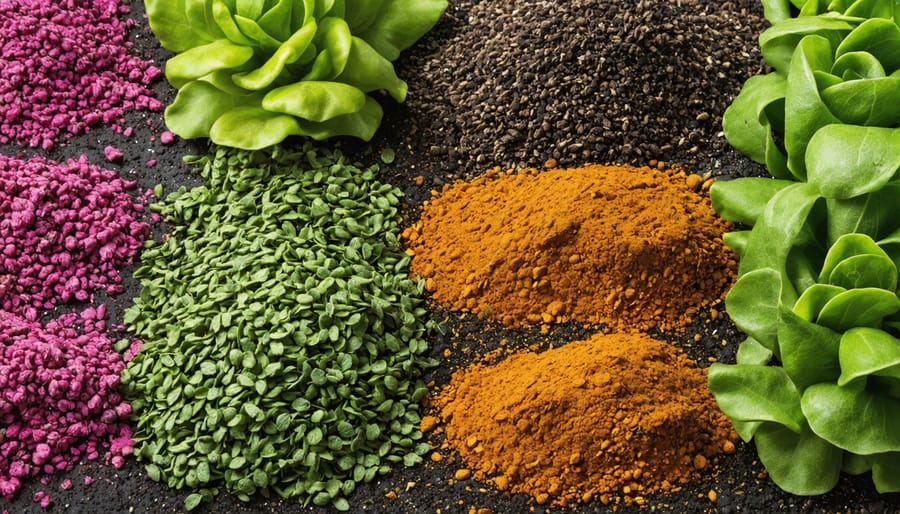
Expert Perspective: Transitioning to 100% Organic Seed
We spoke with Trevor Morrison, an organic transition specialist and agronomist based in Red Deer, Alberta, who has guided over forty farms through the organic certification process. His insights reveal both the practical realities and achievable pathways for meeting organic seed requirements.
“The biggest misconception I encounter is that farmers think they need 100% organic seed from day one of their transition,” Morrison explains. “The USDA standards—which align with Canadian requirements—actually provide a reasonable framework. You document your search efforts, use commercially available organic seed where it exists, and apply for exemptions when it doesn’t. The key is understanding which crops have strong organic seed availability and planning accordingly.”
Morrison points to pulse crops as a success story for Alberta producers. “Organic lentil and pea seed has become much more accessible in the past five years. I worked with a farmer near Drumheller who transitioned 160 hectares to organic production. We started with crops that had reliable organic seed sources—green lentils, yellow peas, and flax—while his land completed the three-year transition period. By year four, when he needed full organic inputs, he had established relationships with organic seed suppliers and even saved some of his own seed.”
The timeline consideration matters significantly. “I always recommend farmers start sourcing conversations at least eight months before planting,” Morrison advises. “Contact multiple suppliers, compare genetics and pricing, and document everything. Those records become part of your organic system plan and demonstrate due diligence to your certifier.”
For crops with limited organic seed availability, Morrison suggests creative solutions. “One cooperative approach I’ve seen work involves three neighbouring farms near Lacombe. They coordinated their crop rotations and dedicated portion of their acreage to growing certified organic seed for each other. This reduced external input costs and strengthened their local organic community.”
His most practical advice? “Start small with crops that have established organic seed markets. Build your knowledge and supplier relationships gradually. The transition isn’t just about land—it’s about developing a completely different supply chain mindset. Give yourself grace in that learning process.”
Understanding USDA organic seed standards equips you with the knowledge to make informed decisions that strengthen your organic operation. Whether you’re pursuing USDA certification for export markets or simply want to align with best practices, the three-tier hierarchy—organic first, untreated conventional when organic is commercially unavailable, then treated seeds with proper documentation—provides a clear roadmap.
For Canadian farmers, the key takeaway is that sourcing organic seed isn’t just about meeting certification requirements. It’s about investing in the genetic diversity and adaptive traits that make your farming system more resilient. Every time you choose certified organic seed, you’re supporting breeding programs that prioritize soil health, natural pest resistance, and climate adaptability—traits that matter increasingly as prairie growing conditions shift.
Start with practical steps: build relationships with organic seed suppliers, document your sourcing efforts thoroughly, and explore the assistance programs available to support your transition. Connect with other organic farmers in your region to share seed sources and variety experiences.
Remember, compliance doesn’t have to be overwhelming. The regulations exist to protect the integrity of organic agriculture and ensure consumers can trust the organic label. By embracing these seed standards, you’re not just checking boxes—you’re contributing to a farming system that prioritizes ecological health, biodiversity, and long-term sustainability. Your seed choices today are planting the foundation for tomorrow’s thriving organic agriculture community across the prairies.

